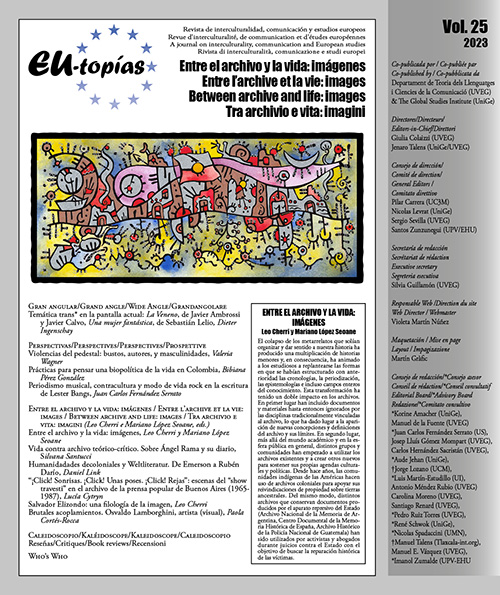Salvador Elizondo: A Philology of the Image
DOI:
https://doi.org/10.7203/eutopias.25.26536Keywords:
Literatures of the world, Salvador Elizondo, postphilology, anarchivism, image. Abstract
Abstract
The same year that Salvador Elizondo releases his film Apocalypse 1900, which will remain archived in cans until 2007, he also publishes Farabeuf o la crónica de un instante. This survival and recovery of the film archive illuminates the literary text and allows us to see what was always there: Farabeuf is not only an intermediate book –which incorporates and reflects on images– or an experimental book that takes Bataillean aesthetics to its ultimate consequences, but, above all, an intervention in the archives of modernity, a montage-writing that intervenes in and from certain archives that define modernity. This paper proposes to analyze Elizondo’s novel and film from these postulations, trying to think about the place of his intervention in Latin American literature and the arts of the twentieth century from a postphilological and anarchivistic perspective.
 Downloads
Downloads
 References
References
Antelo, Raúl. Archifilologías latinoamericanas. Lecturas tras el agotamiento. Córdoba: EDUVIM, 2015.
Alberdi, Begoña. «Salvador Elizondo: iconología del cuerpo y el dolor». Revista Laboratorio, 12, 2019.
Borges, Jorge Luis. Obras completas (1923-1972). Bs. As.: Emecé, 1974.
Buck-Morss, Susa. «Estética y anestesia: Una reconsideración del ensayo sobre la obra de arte» Walter Benjamin, escritor revolucionario. Traducción de Mariano López Seoane. Bs. As.: Interzona, 2005 [1992].
Deleuze, Guilles. Diferencia y repetición. Bs. As.: Amorrortu, 2009 [1967].
—.Lógica del sentido. Traducción de Miguel Morey. Edición Electrónica de www.philosophia.cl / Escuela de Filosofía Universidad ARCIS, 1969.
—. Foucault. Traducción de José Vázques Pérez. Barcelona: Paidós, 1987 [1986].
De los Ríos, Valeria. «Imaginario apocalíptico, cuerpo y tecnología en Apocalypse 1900 y Farabeuf o la crónica de un instante de Salvador Elizondo». Estudios 20, 39, 2012, pp. 19-37.
Elizondo, Salvador. Farabeuf o la crónica de un instante. Edición 50° aniversario. México: Colegio nacional, 2015.
—. Cuaderno iconográfico
—. Diarios 1945-1985. Prólogo, selección y notas de Paulina Lavista. México: Fondo de Cultura Económica, 2015.
—.«El más allá de la escritura. Una entrevista con Salvador Elizondo». Entrevistadora: Silvia Lemus. Nexos, 238, 1997 (octubre). Disponible: http://www.nexos.com.mx/?p=8572, 26/09/2016
—.Camera lucida. México DF: Editorial Joaquín Mortiz, 1983.
Ette, Ottmar et al. La filología como ciencia de la vida. Berlin: Universidad Iberoamericana, 2015.
Eribon, Didier. Una moral de lo minoritario. Variaciones sobre un tema en Jean Genet. Trad. Jaime Zulaika. Barcelona: Anagrama, 2004.
Foster, Hall. «An Archival Impulse», October, 110, 2004.
Foucault, Michel. Las palabras y las cosas. Una arqueología de las ciencias humanas. Buenos Aires: Siglo XXI Editores, 1968.
—. La arqueología del saber. México: Siglo XXI, 1979 [1969].
Hamacher, Werner. 95 tesis sobre filología. Bs. As.: Miño y Dávila Editores, 2011
Manzor-Coats, Lillian. «Problemas en “Farabeuf” mayormente intertextuales». Bulletin hispanique, 88, 1986, pp. 465-476.
Paz, Octavio. «El signo y el garabato». en Salvador Elizondo. Farabeuf o la crónica de un instante. Ed. Salvador Elizondo. Edición 50° Aniversario. México: Colegio Nacional, 2015 [1968].
Reveles, Patricia. «Para una lectura iconotextual de Farabeuf de Salvador Elizondo». TRANS, 4, 2007. https://doi.org/10.4000/trans.212
Sarduy, Severo. Escrito sobre el cuerpo. Buenos Aires: Sudamericana, 1969.
Sontag, Susan. «Sade y Bataille», Revista de la Universidad de México, 3-4, 1977.
Wind, Edgar. Los misterios paganos del Renacimiento. Madrid: Alianza Ed., 1972.
Downloads
Published
How to Cite
-
Abstract159
-
PDF (Español)141
Issue
Section
License
The authors conserve the copyright. All content published in EU-topías. Journal of interculturality, Communication, and European Studies are subject to the license Creative Commons Attribution-NonCommercial-ShareAlike 4.0 license. The full text of the license can be found at <http://creativecommons.org/licenses/by-nc-sa/4.0>
They may be copied, used, disseminated, transmitted and publicly displayed, provided that:
- The authorship and original source of the publication is cited (journal, publisher and URL of the work).
- They are not used for commercial purposes.
- The existence and specifications of this license of use are mentioned.
It is the responsibility of the authors to obtain the necessary permissions for images that are subject to copyright.



